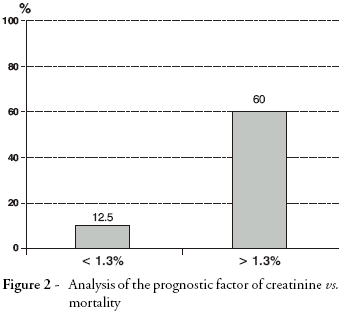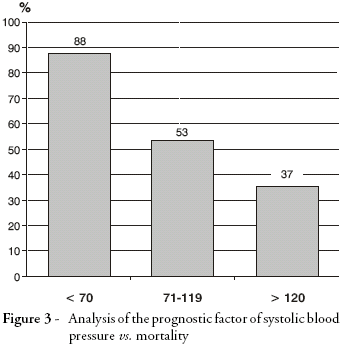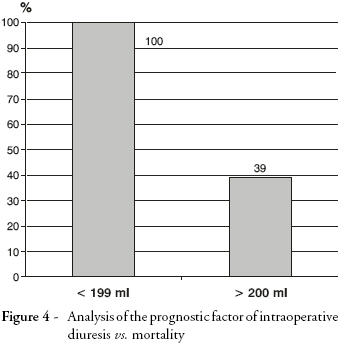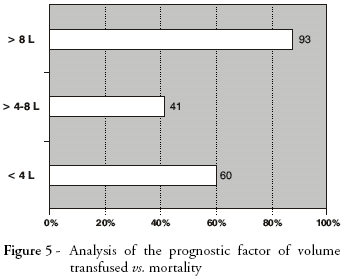Abstracts
OBJECTIVE: To analyze the prognostic factors related to the mortality of ruptured abdominal aortic aneurysm. METHOD: Seventy-two patients who suffered ruptured abdominal aortic aneurysm and were operated in the period between 1976 and 2000 by the Vascular Surgery Unit of the Santa Casa de São Paulo - School of Medical Sciences were retrospectively analyzed. RESULTS: The descriptive analysis of the data shows a mean age of 67.93 years, with a standard deviation of 11.58, 32% female and 68% male. Of the total number, 28% had a previous history of aneurysm and 72% were not aware of the disease. Mean systolic blood pressure during hospital admission was 96.53 mmHg. Pain was present in 100% of the patients, as well as throbbing abdominal mass. In 93% of the cases the location of the aneurysm rupture was the retroperitoneum, 4% in the duodenum, and 2% in the free peritoneum. CONCLUSION: The prognostic factors related to mortality and morbidity that demonstrated statistical significance were: age, initial blood pressure at hospital admission, diuresis during surgery, volume infused, and creatinine levels.
ruptured aneurysm; abdominal aortic aneurysm; morbidity
OBJETIVO: Analisar fatores prognósticos relacionados com a letalidade dos doentes com aneurisma de aorta abdominal roto. MÉTODO: Foram analisados, retrospectivamente, 72 doentes portadores de aneurisma de aorta abdominal roto, operados no período de 1976 a 2000 pela disciplina de Cirurgia Vascular da Santa Casa de São Paulo. RESULTADOS: A análise descritiva dos dados mostra média de idade de 67,93 anos, com desvio padrão de 11,58 anos, sendo 32% do sexo feminino e 68% do sexo masculino. Do total, 28% tinham história prévia de aneurisma e 72% desconheciam a doença. A pressão arterial sistólica na admissão foi de 96,53 mmHg. A dor esteve presente em 100% dos doentes, assim como massa abdominal pulsátil. O local de rompimento do aneurisma foi em 93% dos casos para o retroperitônio, 4% para o duodeno e 2% para peritônio livre. CONCLUSÃO: Os fatores prognósticos relacionados à letalidade que se mostraram com significância estatística foram: idade, pressão arterial admissional, diurese intra-operatória, volume infundido e creatinina admissional.
aneurisma roto; aneurisma da aorta abdominal; morbidade
ORIGINAL ARTICLE
Ruptured abdominal aortic aneurysm: prognostic factors
Aneurisma de aorta abdominal roto: fatores prognósticos
Denise Rabelo da Silveira; Vanessa Prado dos Santos; Aline Faria Lamaita; Henrique Jorge Guedes Neto; Alvaro Razuk Filho; Valter Castelli Jr.; Roberto Augusto Caffaro
Department of Surgery, School of Medical Sciences, Santa Casa de São Paulo, São Paulo, SP
Correspondence Correspondence Denise Rabelo da Silveira Rua São Vicente de Paula, 416/94 CEP 02350-002 São Paulo, SP Phone: (11) 3226.7273 Fax: (11) 3226.7273 E-mail: suely.longui@fcmscsp.edu.br
ABSTRACT
OBJECTIVE: To analyze the prognostic factors related to the mortality of ruptured abdominal aortic aneurysm.
METHOD: Seventy-two patients who suffered ruptured abdominal aortic aneurysm and were operated in the period between 1976 and 2000 by the Vascular Surgery Unit of the Santa Casa de São Paulo School of Medical Sciences were retrospectively analyzed.
RESULTS: The descriptive analysis of the data shows a mean age of 67.93 years, with a standard deviation of 11.58, 32% female and 68% male. Of the total number, 28% had a previous history of aneurysm and 72% were not aware of the disease. Mean systolic blood pressure during hospital admission was 96.53 mmHg. Pain was present in 100% of the patients, as well as throbbing abdominal mass. In 93% of the cases the location of the aneurysm rupture was the retroperitoneum, 4% in the duodenum, and 2% in the free peritoneum.
CONCLUSION: The prognostic factors related to mortality and morbidity that demonstrated statistical significance were: age, initial blood pressure at hospital admission, diuresis during surgery, volume infused, and creatinine levels.
Key words: ruptured aneurysm, abdominal aortic aneurysm, morbidity.
RESUMO
OBJETIVO: Analisar fatores prognósticos relacionados com a letalidade dos doentes com aneurisma de aorta abdominal roto.
MÉTODO: Foram analisados, retrospectivamente, 72 doentes portadores de aneurisma de aorta abdominal roto, operados no período de 1976 a 2000 pela disciplina de Cirurgia Vascular da Santa Casa de São Paulo.
RESULTADOS: A análise descritiva dos dados mostra média de idade de 67,93 anos, com desvio padrão de 11,58 anos, sendo 32% do sexo feminino e 68% do sexo masculino. Do total, 28% tinham história prévia de aneurisma e 72% desconheciam a doença. A pressão arterial sistólica na admissão foi de 96,53 mmHg. A dor esteve presente em 100% dos doentes, assim como massa abdominal pulsátil. O local de rompimento do aneurisma foi em 93% dos casos para o retroperitônio, 4% para o duodeno e 2% para peritônio livre.
CONCLUSÃO: Os fatores prognósticos relacionados à letalidade que se mostraram com significância estatística foram: idade, pressão arterial admissional, diurese intra-operatória, volume infundido e creatinina admissional.
Palavras-chaves: aneurisma roto, aneurisma da aorta abdominal, morbidade.
The rate of aortic aneurysms is estimated to be 2.5% in the male population between 65 and 74 years, possibly reaching up to 9% in patients over 75 years of age.1 In the period between 1951 and 1980, a significant increase was observed in the rate of abdominal aortic aneurysm (AAA) from 12.2/100,000 to 36.2/100,000 inhabitants.2,3
Ruptured AAA is the most frequent and most serious complication, with 20-40/100,000 cases each year, and could be the first aneurysmal manifestation in up to 50% of the cases, representing 1.1% of all deaths in the male population over the age of 50.1,4 Its rate rises relative to age and reaches its peak in the 80-89 male age group, with rates of 112.7/100,000 and rates of 67.7/100,000 in women older than 90 years.2
The mortality of ruptured AAA varies between 15 and 68%, with mean of 50%, which demonstrates a great contrast when compared to the mortality of 2.9% in patients submitted to optional/elective surgery.2,5,6 Most authors speculated a significant rise in the mortality of these patients, approximately 90%, if patients with home deaths are included, due to the fact that only 50% of these arrive to the hospital alive.1,5,7
Due to significant improvements of the survival rate of patients with this affliction in the last decade attributed to the progress in all treatment stages from pre-hospital care to more developed surgical and anesthetic techniques a more detailed study was virtually mandatory to find out why there is such elevated inferior prognostic rates in patients with ruptured AAA.2,8
Hemorrhagic shock and reperfusion/ischemic syndrome may lead to tissue lesions with the liberation of free radicals, activating neutrophils and the release of inflammatory mediators. Free radicals cause lipoprotein membrane lesions causing changes in cellular function, contributing to post-surgery multiple organ and system failure, which explains the higher difficulty to treat these patients and may explain the poor prognostic, despite all the advanced techniques mentioned in the literature.9
All patients presented a diversity of factors that determined a greater predisposition to aneurysm rupture, and a worse prognosis after surgical treatment of ruptured AAA. Therefore, there is a need for understanding the contribution for the prognosis of each of these factors individually.2,10 Other authors in the last decade studied factors that could be used as early risk factors predisposing to increased mortality.1,2,5,6,11
The factors most frequently studied can be divided into preoperative (previous coronary disease, chronic obstructive pulmonary disease, systolic blood pressure, hematocrit, creatinine, gender and age) and intraoperative (aortic clamping time, location of aortic clamping, surgery duration, diuresis, and infusion volume).1,2,5,6,8,11
The goal of this study was to analyze prognostic factors that determine premature death in patients with ruptured AAA.
Patients and methods
A retrospective analysis was done of all cases of ruptured AAA admitted to the Emergency Service of the Santa Casa de Misericórdia Hospital de São Paulo from January 1976 to December 2000 that were submitted to surgical treatment by the Vascular Surgery Unit of this service. All patients admitted with ruptured AAA in the emergency room were submitted to surgical treatment, and all of them were included for analysis, even the ones who died in the operating room.
Seventy-two patients were analyzed and initially included in the protocol, divided into subgroups according to the prognostic factors to be studied, and morbidity rates of each group submitted to statistical analysis. Some patients were excluded from a few subgroups because they did not have all the information analyzed in this specific group factor.
Statistical analysis was made using the chi-square and Fisher's exact test, admitting a P < 0.005. The chi-square test was used for the factors of age, gender, creatinine level, systolic blood pressure, aortic clamping duration, volume transfused and surgery duration. The rest of the factors were analyzed using Fisher's exact test depending on the size of the group.
Results
The sample was comprised of 32% female patients and 68% male patients, with a general mortality rate reaching 54%. Mean age was of 67.93 years, with a standard deviation of 11.58 years. Previous history of AAA was present in 28% of cases and 100% presented abdominal pain and throbbing abdominal mass when admitted to the hospital.
The aneurysms presented a mean diameter of 8.17 cm, with a standard deviation of 2.57 cm. The retroperitoneum was the most common location for rupture (93%), followed by the duodenum (4%) and free peritoneum (2%).
Mean blood pressure was 96.53 mmHg, with a standard deviation of 41.01 mmHg. Duration of aortic clamping had a mean of 109.71 minutes, with a standard deviation of 55.5 minutes; surgery duration had a mean time of 4.22 hours, with a standard deviation of 1.37 hours. This subgroup was composed of: 17 cases with blood pressure lower than 70 mmHg; 27 cases higher than 119 mmHg and 28 cases in between.
When gender was analyzed as a prognostic factor, the mean death rate was 57% for male patients and 52% for female patients, but it presented no statistical significance (P = 0.69), which demonstrates that gender is not related to the mortality rate in our study.
Age proved to be a significant (P = 0.002) prognostic factor, with a higher death rate in the age groups between 61-70 years (90%) and 71-80 years (83%), showing that age and morbidity are directly proportional factors (Figure 1). Our group study was composed of: five patients with 40-50 years (one death); 11 patients with 51-60 years (three deaths); 24 patients with 61-70 years (10 deaths); 18 patients 71-80 years (15 deaths); 14 patients 81-90 years (11 deaths).
The prognostic factor of creatinine during hospital admission shows a death rate of 60% in groups with creatinine levels over 1.3 mg/dl (n = 30 patients) and of 12.5% with creatinine lower than 1.3 mg/dl (n = 16 patients), with a statistically significant difference between groups (P = 0.002) (Figure 2). Twenty-six patients were excluded because we did not have all the information required.
Blood pressure during hospital admission proved to be inversely proportional to death rate, with a higher rate (88%) in patients with pressure index less than 70 mmHg (P = 0.003), (Figure 3).
Intraoperative diuresis was related to death rates of 100% in patients with less than 199 ml (P = 0.008) (Figure 4). This group study was composed by: 38 patients with over 200 ml of diuresis (15 deaths) and 06 patients less than 199 ml (six deaths). Twenty-eight patients were excluded because we did not have all the information required.
Aortic clamping time did not prove to be related to prognosis (P = 0.29). Mean clamping time was 109 minutes, with a standard deviation of 55.51 minutes.
An improved prognosis was observed in patients who received between 4 and 8 l of transfused volume (41%) compared with patients who received over 8 l or under 4 l (P = 0.002), showing a statistically significant difference between volume transfused and death rate (Figure 5).
The variables of surgical time, hematocrit, and aneurysm size are not related to a better or worse prognosis. Our group study was comprised of 23 patients with hematocrit lower than 29 mg/dl and 10 patients above it. We did not have the hematocrit value for 39 cases.
Discussion
The signs and symptoms that accompany ruptured AAA are usually dramatic. Sudden abdominal pain that radiates to the back seems to be present in nearly 70% according to the literature, and is associated to a throbbing abdominal mass during physical examination in 80% of cases.8 In our study, the presence of abdominal pain and abdominal mass and mortality was 100 and 54%, respectively, which is consistent with the literature.
There was a predominance of 68% in males, results that are similar to most studies that evidence gender incidence, which varies in the ratio of 4:1 for men.2,5 As in the literature, the gender factor alone does not seem to have a strong correlation with the prognosis.
Regarding the location of the ruptured aneurysm, 93% of cases were in the retroperitoneum, with only 2% occurring in the free peritoneum. In general, a higher incidence of rupture in the free peritoneum is described with a higher mortality rate, even though this is not a consensus in the literature. Gloviczki et al. and Wakefield et al. claim that a lower incidence of ruptures in the free peritoneum reflects an inferior prognosis for patients who would have a faster evolution and thus represents the group of home deaths, being therefore a repercussion of the pre-hospital care.6,8
Age has been cited as an important variable for the prognosis, even though it is mainly considered a contributive factor and not an independent one.2,8 Crawford et al. and Johansson & Swedenborg showed a higher morbidity rate in octogenarians, but agree that the age factor alone should never contraindicate surgical treatment.6,12,13 Furthermore, there are authors who believe age has no association with morbidity.5,11 In our study, we observed that the age group is a factor that presents a strong connection with morbidity, being directly proportional variables.
The hypovolemic shock is the most common factor associated to ruptured AAA. It is in general agreement that low-pressure levels during hospital admission are strong predictors of morbidity. In our unit, the place where preoperative pressure levels were determined was inversely proportional to morbidity, with higher rates with levels under 70 mmHg (80%). Crawford et al.12 advocate that preoperative resuscitation should be performed with little volume maintaining pressure levels between 50 and 70 mmHg until aortic clamping is performed, due to the fact that higher pressure levels are related to the detachment of thrombus and subsequent hemodynamic instability. Several services believe that such low pressure levels result in a higher morbidity rate with a higher incidence of multiple organ failure.1,2,5,8,11
With regard to necessary volume restitution, we observed that patients who received more than 8,000 ml and less than 4,000 ml had a better prognosis than the patients who received intermediary levels. In general, estimated volume loss was a determinant factor in inferior prognosis in most cases and aggressive volume restitution followed such results. A better prognosis was observed in services that advocate quick control of volume loss through aortic clamping or placement of an intra-aortic balloon, thus causing a reduction in volume loss and consequent volume restitution.8,14
Lindsay et al.2 found a lower survival rate in patients who presented creatinine levels higher than 1.3 mg/dl, showing that creatinine levels are factors strongly associated with morbidity. In our study, there was a morbidity rate of 60% in patients with creatinine higher than 1.3 mg/ml, with statistical analysis showing that this factor is strongly associated with lethality. When renal function is altered before the surgical procedure, there is a higher risk of postoperative deterioration, and if this complication is present, a high morbidity rate is observed.14
As well as creatinine levels, intraoperative diuresis proved to be an independent indicator of morbidity with a higher lethality rate in patients with diuresis less than 199 ml (100% lethality), consistent with other studies in the literature, which show a strong correlation between diuresis and morbidity.2
There is an agreement that the duration of aortic clamping is a determinant factor of worse prognosis and is related to postoperative renal insufficiency, as well as sepsis and pulmonary complications; lack of such complications in our study may be explained by the size of our sample and could be better studied with an increase in the number of patients in a future study.2,5,14 The Brazilian literature has some descriptions of different forms of aortic clamping that can help in surgery, such as the aortic compressor, which can be done with a smaller incision, a quicker one, stopping the bleeding while the rest of the incision is made. Another form of aortic clamping time is the use of a catheter with a balloon implanted through the brachial artery, which is insufflated in the aorta.15 Unfortunately, we did not have access to those techniques and in all our cases the aortic clamping was made by clamping the infrarenal aorta in the surgery.
Similarly to clamping time, surgical duration seems to have a strong relation with an inferior prognosis, although it has not been evidenced in our study. Surgical duration of more than 300 minutes reveals a higher lethality, with rates of 100% in a period greater than 400 minutes.8
Aneurysm size is classically related to aneurysm rupture. Sterpetti et al.16 report that rupture occurs in 9.5% of aneurysms smaller than 4 cm, 24.5% between 4 and 7 cm, and 59.4% in patients with aneurysms larger than 7 cm. However, there is no scientific evidence that aneurysm size has any correlation with a better or worse prognosis after rupture.
Hemoglobin values under 11 g/dl are related to a morbidity of 67%, while morbidity rates of 27% were observed with higher values of hemoglobin.8 Preoperative hematocrit values were assessed in our study and statistical analysis did not match the previously reported findings.
A great unknown fact that motivated our study of prognostic factors related to lethality of ruptured AAA was the belief that an associated factor or associated factors could characterize inferior prognosis and, by correcting such factors could improve the evolution of these patients. In this way, several authors in the last decade investigated the relationship of isolated and associated factors.
Some authors such as Crawford et al.12,17 and Gloviczki et al.6 believe that no factor or association of factors should contraindicate surgical treatment, even finding mortality rates of 90% in some subgroups, such as female patients over the age of 80 with admission hematocrit levels lower than 25% and with mortality of 100% in patients with previous serious coronary complications.
On the other hand, Johansson & Swedenborg13 believe that in some situations surgery should not be performed, in accordance with Hardman et al.18, who propose in their study that age over 76 years, loss of conscience after arrival, hemoglobin inferior to 9%, ischemia identified in the electrocardiogram and creatinine levels higher than 0.19 mmol/l to be used as criteria, in which the presence of three or more of such factors should be considered as a contraindication to surgical treatment, since these patients present mortality rate of 100%.13
In general it is believed that these criteria should be extremely necessary postsurgically as an additional factor to indicate or not a more aggressive clinical treatment for patients with lower chances of evolution. The endovascular treatment has been advocated as an alternative to open surgery for patients with ruptured AAA with low mortality rates, but with a high percentage of secondary interventions.19 However, it is limited by morphologic aneurysm characteristics (including neck length and diameter) and by the patient's hemodynamic conditions.
In summary, we demonstrated in this study that the prognostic factors of age, creatinine levels, systolic blood pressure, intraoperative diuresis, and volume transfused have strong association as indicators of premature mortality in ruptured AAA.
Acknowledgments
We are grateful to the Support Center for Scientific Publications of Santa Casa de São Paulo School of Medical Sciences for the editorial assistance.
Article submitted on May 19, 2005, accepted on October 13, 2005.
- 1. Merlo M, Carignano G, Bitossi G, et al. Personal experience of the treatment of ruptured aortic aneurysms. The prognostic evaluation of some parameters. Minerva Cardioangiol. 2001;49:179-87.
- 2. Lindsay TF, Johnston KW. Ruptured abdominal aortic aneurysm: from diagnosis to discharge. In: Advances in vascular surgery 3. Whittemore AD, Bandyk D, Cronenwett J, Hertzer N, White R, editors. Chicago: Mosby Year-Book Inc.; 1995. p. 127-148.
- 3. Ernst CB. Abdominal aortic aneurysm. N Engl J Med. 1993;328:1167-72.
- 4. Wilmink TB, Quick CR, Hubbard CS, Day NE. The influence of screening on the incidence of ruptured abdominal aortic aneurysms. J Vasc Surg. 1999;30:203-8.
- 5. Murphy JL, Barber GG, McPhail NV, Scobie TK. Factors affecting survival after rupture of abdominal aortic aneurysm: effect of size on management and outcome. Can J Surg. 1990;33:201-5.
- 6. Gloviczki P, Pairolero PC, Mucha P Jr, et al. Ruptured abdominal aortic aneurysms: repair should not be denied. J Vasc Surg. 1992;15:851-7.
- 7. Marston WA, Ahlquist R, Johnson G Jr, Meyer AA. Misdiagnosis of ruptured abdominal aortic aneurysms. J Vasc Surg. 1992;16:17-22.
- 8. Wakefield TW, Whitehouse WM Jr, Wu SC, et al. Abdominal aortic aneurysm rupture: statistical analysis of factors affecting outcome of surgical treatment. Surgery. 1982;91:586-96.
- 9. Lindsay TF, Luo XP, Lehotay DC, et al. Ruptured abdominal aortic aneurysm, a "two hit" ischemia/reperfusion injury: evidence from an analysis of oxidative products. J Vasc Surg. 1999;30:219-28.
- 10. Meyer AA, Ahlquist RE Jr, Trunkey DD. Mortality from ruptured abdominal aortic aneurysms. A comparison of two series. Am J Surg. 1986;152:27-33.
- 11. Hatori N, Yoshizu H, Shimizu M, et al. Prognostic factors in the surgical treatment of ruptured abdominal aortic aneurysms. Surg Today. 2000;30:785-90.
- 12. Crawford ES, Saleh AS, Babb JW III, Glaeser DH, Vaccaro PS, Silvers A. Infrarenal abdominal aortic aneurysm: factors influencing survival after operation performed over a 25-year period. Ann Surg. 1981;193:699-709.
- 13. Johansson G, Swedenborg J. Ruptured abdominal aortic aneurysms: a study of incidence and mortality. Br J Surg. 1986;73:101-3.
- 14. Bauer EP, Redaelli C, von-Segesser LK, Turina MI. Ruptured abdominal aortic aneurysms: predictors for early complications and death. Surgery. 1993;114:31-5.
- 15. Bonamigo TP. Aneurismas rotos da aorta abdominal. In: Brito CJ, et al. Cirurgia vascular. Vol I. Rio de Janeiro: REVINTER; 2002. p. 503-513.
- 16. Sterpetti AV, Cavallaro A, Cavallari N, et al. Factors influencing the rupture of abdominal aortic aneurysms. Surg Gynecol Obst. 1991;173:175-8.
- 17. Crawford ES. Ruptured abdominal aortic aneurysm. J Vasc Surg. 1991;13:348-50.
- 18. Hardman DT, Fisher CM, Patel MI, et al. Ruptured abdominal aortic aneurysms: who should be offered surgery? J Vasc Surg. 1996;23:123-9.
- 19. Hechelhammer L, Lachat ML, Wildermuth S, Bettex D, Mayer D, Pfammater T. Midterm outcome of endovascular repair of ruptured abdominal aortic aneurysms. J Vasc Surg. 2005;41:752-7.
Publication Dates
-
Publication in this collection
08 May 2006 -
Date of issue
2005
History
-
Accepted
13 Oct 2005 -
Received
19 May 2005






